
British people say: "An apple a day keeps the doctor away."
Scientists of the subsidiary organization of the “National agrarian science and educational center” JSC - Zhazken Zhiembayev Kazakh Research Institute of Plant Protection and Quarantine, gave a number of recommendations on the protection of fruit crops from harmful organisms.
Gardening is one of the most important sectors of agriculture in the south and southeast of Kazakhstan. Along with the further development of grain farming, animal husbandry and other sectors of agricultural production, great attention should be paid to increasing the production of orchards, without which it is impossible to imagine a balanced nutrition of the population. The latter is one of the indicators of the culture, well-being and health of the nation. Therefore, Kazakhstanis should have everything on the table: bread, meat, vegetables, and, of course, fruits.
Meanwhile, Kazakh scientists calculated that with high technology of cultivation of orchards, with serious support of the industry by the state, our three regions (Almaty, Zhambyl and Turkestan) can fully provide the 18 million population of the country with fruits, without importing them.
Among the measures aimed at increasing the productivity of gardens and improving the quality of their products, the most important place is taken by effective protection from harmful organisms, which is figuratively called the "invisible front".
Fruit crops are damaged by more than 50 types of harmful insects, and about 20 types of infectious diseases are affected.
After flowering, those who like to “feast on” the emerging fruits enter the “arena” - apple and plum moths, mites and scale insects sucking leaves and shoots. Of the diseases, scab and powdery mildew continue to infect fruits and leaves, fruit rot begins to develop, and bacterial burns are gaining momentum.
Knowledge of the characteristics of the biology of the pest, the mechanism of action of chemical and biological preparations, agrotechnical measures carried out in the garden, make it possible to get a high quality crop.
Expressed systemic effect of the drug Aktara 250, water dispersible granules gives an excellent effect against red blood aphids: penetrating through wax hairs it destroys the pest, and also has an additional effect against harmful insects that hide and feed on the underside of the leaves. To destroy the wintering stage of blood aphids on the roots, in the fall after harvesting, it is recommended to use this drug by shedding soil in the near-trunk circle with a consumption rate of 2-4 g / tree.
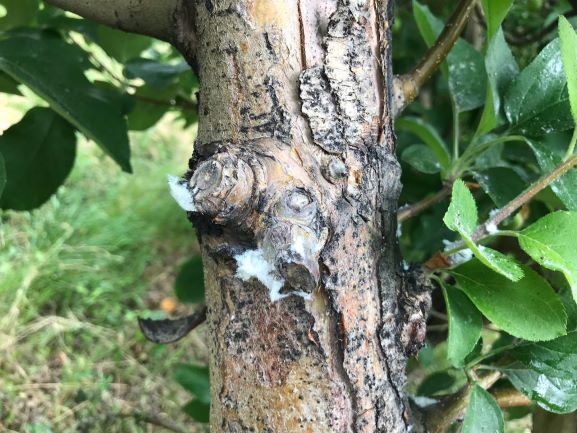
On stone rocks, organophosphorus compounds provide guaranteed quality in the fight against scale insects and false scales.
Although ticks do not reach the economic threshold of harmfulness from early spring to flowering, some insecticides and biological products can control their number, effectively suppressing accompanying pests - leaf rollers and aphids.
In the phase of "separation of buds" and as the fruit grows in a damp cool spring, when the first signs of scab damage are detected, it is necessary to use the fungicides Skor 250, emulsion concentrate 0.15-0.2 l / ha, its analogue Raek with the same consumption rate, and with a strong development of the disease, treatment can be repeated after 7-10 days. The active substance of these drugs is based on the suppression of the formation, germination and sporulation of the fungus. At the beginning of the growing season against powdery mildews, there are specialized preparations Topaz 100, emulsion concentrate and Mystic emulsion concentrate, with a consumption rate of 0.5-1.0 l / ha, their use in the initial growing season has a preventive effect. Against a bacterial burn during this period, it is recommended to use Kasumin 2L, 2% w.r., 2-4 l / ha and the drug Kosaid 2000 water dispersible granules 2.0-3.0 kg / ha. Kasumin can also be used during flowering.
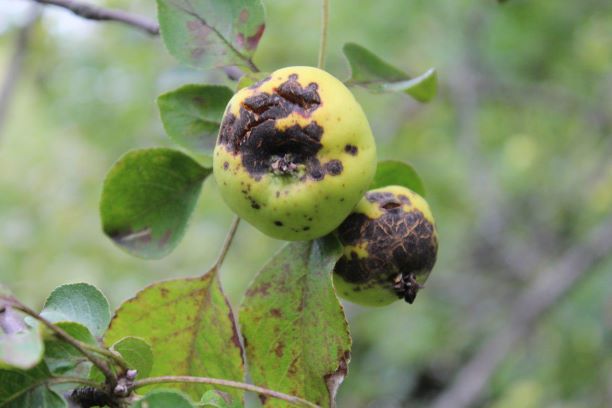
We must not forget about the weeds in the garden. Herbicide treatments are usually carried out in a row 2 meters wide, the herbicide fallow eliminates weed competition and create better conditions for volunteer harvesting in summer and harvesting in autumn, while protecting young tree stands.
In addition to chemical means of protection, it is recommended to use biological preparations (Lepidotsid, Ak kobelek, etc.) and fertilizers containing amino acids and peptides available to the plant.
In the second half of the growing season, a new stage of protecting gardens from harmful organisms begins.
Thus, the apple moth (Yponomeuta mallinellus Zell), during the flowering of the apple tree, emerges from the mines and goes to open feeding, completely eats up young leaves, leaving only veins. Its harmfulness lies in the fact that during flowering it is impossible to carry out chemical treatment due to the danger of poisoning bees, natural pollinators - a guarantee of the future harvest. However, it is possible to fight the apple moth immediately after flowering (when 80% of the petals fall off).
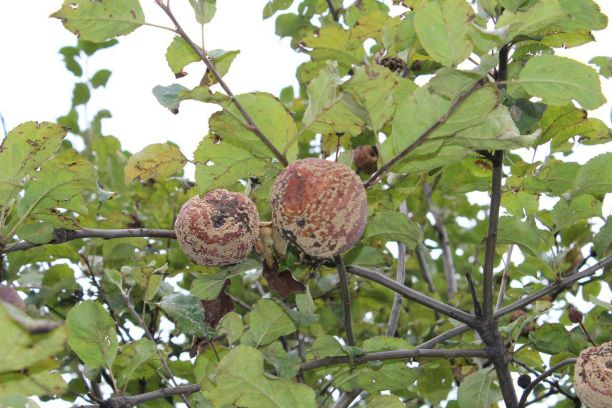
2-3 weeks pass before the formation of dense spider nests and pupation, and this moment must be used to carry out protective measures against apple moth, it is recommended to treat the garden with one of the following insecticides: Agrocip, 10% emulsion concentrate with a consumption rate of 0.2-0.3 l / ha, Gyukharad, 5% emulsion concentrate, 0.4-0.8 l / ha, Sharpei, 0.16-0.32 l / ha, Nurell D, emulsion concentrate 1.5 l / ha.
In the second half of the growing season, the most harmful object in the garden is the codling moth (Car-pocapsa pomonella L.), causing the worminess of the fruits, reduces their quality, and the fruits become unusable.
The butterfly has a wingspan of 17-20 mm, dark gray. The egg is round, flattened, greenish-white, on the surface of the leaf and fruit it looks like a small droplet of wax. The adult caterpillar is 18-20 mm long, light pink. Pupa 10-12 mm long, light brown, enclosed in a spider cocoon.
Adult caterpillars overwinter in dense cocoons under peeling bark, in cracks in the trunk and skeletal branches. In young gardens, where trees with smooth bark, caterpillars overwinter in the upper soil layer up to 3 cm deep.
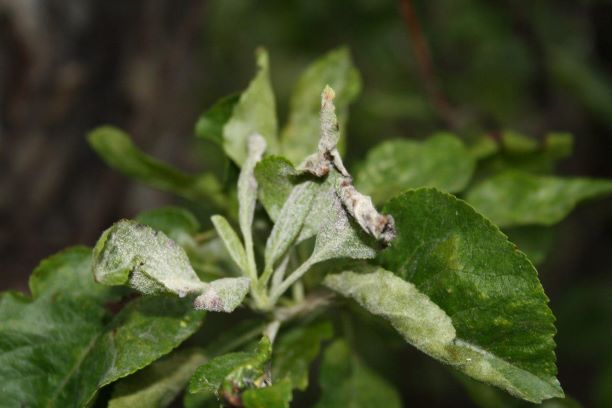
With the onset of an average daily temperature above 10 ° C (the lower threshold for the development of the codling moth), over-rescued caterpillars begin to pupate. Pupal stage in spring 18-20 days. The beginning of the emergence of butterflies is observed at the end of flowering of winter varieties of apple trees. The em-bryonic period of development of eggs of the first generation lasts 8-12 days. The massive butterfly summer lasts up to two weeks.
To determine the timing of the first processing, several methods are recommended. For example, by the sum of effective temperatures. It is known that the hatching of caterpillars from eggs occurs when the sum of the average daily temperatures exceeding 10 ° C is 230 ° C.
Some experts recommend the first treatment against the spring generation to be carried out according to the apple-tree phenophases: during the period of abscission of the excess ovary or in 2-3 weeks after flowering of late varieties.
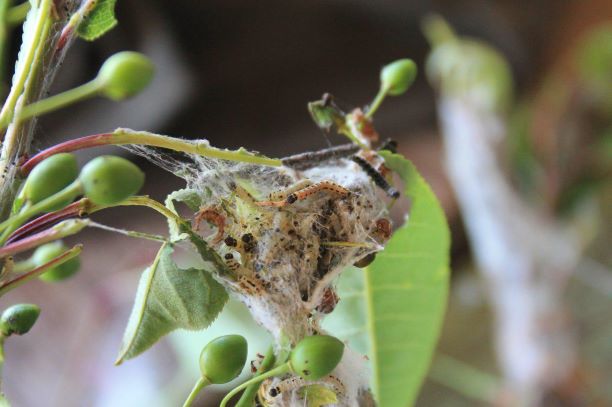
There is another simple method, which is more suitable for summer cottages and backyards - monitoring the development of pupae, every 5-6 days in the hunting belts placed last year. If we admit, out of 25 pupae in the belt there are 5-6 empty skins, this speaks of the beginning of butterfly summer. Caterpillars hatch usually after 10-12 days, which is the signal for the first treatment. The economic threshold of harmfulness (EPV) for the first generation of the codling moth is 1.5-2% of damaged fruits.
The most harmful is the second generation of the codling moth. The mass summer of butterflies, according to long-term observations, in the Almaty fruit zone falls on July 15-20, in the south - two weeks earlier. A week after the mass summer of butterflies, insecticide treatment is carried out and repeated after 12-14 days. In the south of Kazakhstan, the apple moth gives three generations, which requires additional processing.
Thus, against the codling moth - the most malicious pest of gardens, if necessary, 4-5 spraying should be carried out, depending on the conditions of the year.
Recommended protection measures against the codling moth - Systematic collection of volunteers. Before harvesting, the trees are shaken off to cause the abscission of the worm fruits.
In the autumn, the boles and skeletal branches are cleaned with a blunt scraper from dead bark, under which the caterpillars are taken. Digging near-trunk circles, collecting plant residues help to reduce the number of pests.
The main method of protection is chemical. Against the spring generation of the codling moth, processing is carried out when the economic threshold of harmfulness is reached. Usually one treatment is sufficient.
Against the codling moth of the first generation, as well as subsequent ones, one of the following preparations is recommended: Karate 050, emulsion concentrate, 0.4-0.8 l / ha or Karate Zeon 050, 0.4-0.5 l / ha, Koragen, 0.15-0.30 l / ha; Bi-58 new, 40% eq, 1.4 l / ha; Borey, 0.3 l / ha; Engio 247, 0.3-0.4 l / ha. To avoid pest resistance, drugs should be alternated. Against the second generation moth (the most harmful), the garden is treated twice with an interval of 12-14 days. Against the third generation in the south - 1, 2 times, depending on the number of pests. When using these preparations, the processing is stopped 20 days before the harvest.
Hanging pheromone dispensers in the garden not only reduces the damage to the fruit by the pest, but also reduces the frequency of treatments, preserves the ecology, and is an important link in the integrated garden protection system.
A dangerous pest of the orchard that damages leaves is the round moth.
The Cemiostoma scitel-la L. is one of the harmful species among the mining moths. Making numerous mines on the leaves, the moth suppresses their photosynthetic activity, and causes premature leaf fall, which leads to a decrease in the yield and its quality.
The moth butterfly is very small, with a wingspan of 6-7 mm, grayish-white with a silvery tinge. The egg is oval with a curved top; the adult caterpillar is grayish-green, up to 5 mm long.
Pupae overwinter in dense diamond-shaped cocoons in cracks and under peeling bark of trunks and branches, among fallen leaves, in the surface layer of soil. According to the observations of experts from the moth and apple moth butterflies, their further developmental phases are almost synchronous. Butterflies lay their eggs on the underside of the leaf. The embryonic period is 8-10 days. The caterpillar that emerged from the egg makes rounded mines, where it feeds and develops. Mines appear after apple blossoms.
Pupation occurs on the underside of the leaves. After 1.5-2 weeks, butterflies fly out, which lay eggs and give rise to the development of the next generation. In the Almaty fruit zone, the pest gives 3-4 generations, in the south of the republic - 5 generations.
Recommended protective measures. Digging near-free circles and collecting fallen leaves in autumn or early spring, with their subsequent destruction, to a certain extent reduces the wintering stock of the pest.
Due to the hidden way of life of the moth, inside mines they are inaccessible for contact and intestinal insecticides. Therefore, it is recommended to use the drug Nurell D, against the moth (1.5 l / ha), which, with its fumigant effect and through the steam phase, causes the death of caterpillars inside the mine.
Of course, we have not forgotten about such sucking pests as aphids, scale insects, ticks, which were described earlier. These pests continue to cause harm in the second half of the growing season. Treatments against apple moth and leafworms with Decis Expert and Nurell D, Ph.D. simultaneously act against green apple aphid and garden spider mite.
The basis of the protective program during this period should be the codling moth. Repeated chemical treatment against the moth (from 3 to 5) and other methods of protection can be combined with protection against other pests. For example, the drugs used against the codling moth are simultaneously directed against a complex of other pests. In addition, some agro-technical techniques also contribute to the destruction of a complex of pests in the garden.
Among the diseases of fruit crops, the following types can be distinguished:
Moniliosis - Fruit rot (Monilia cinerea and M. fructigena). The first pathogen causes a burn, in which flowers, ovaries, fruit twigs and leaves turn brown and dry, but the branches do not fall off. Outwardly, the symptoms of a monilial burn are similar to a bacterial burn, the difference is the absence of exudate. The second pathogen causes fruit rot, appears in places of damage by the codling moth, cracks caused by scab damage. Over time, numerous gray sporulation pads in the form of concentrated circles form on the decaying tissue. Spores are spread by wind, rain, insects and re-infect neighboring fruits, infected fruits are mummified (dry up) and turn black, remaining hanging on the branches, they are a source of constant infection.
During the growing season, infection occurs with conidia, which are carried by the air current. Fruit onset usually occurs when the fruit reaches the size of a walnut. Massive years, spore and infection occurs in rainy and humid weather.
Recommended protection measures: in autumn and early spring, it is necessary to collect and destroy mummified fruits both on the tree and in the aisles and near-trunk circles. An effective protection against the codling moth and leafworm is required; fruits should be protected from mechanical damage, especially during harvesting.
It should be emphasized that scab and powdery mildew continue their intensive development in the second half of the growing season.
The greatest effect is obtained by treating trees with the Horus 750 fungicide, with a consumption rate of 0.2 kg / ha, in the first half of the growing season, immediately after flowering and when the fruits reach the size of a walnut.
Claster-osporium carpophilum Aderh.- very harmful disease of stone fruits. Various organs of trees are affected by the disease, the yield is sharply reduced, the leaves fall off prematurely, the sprouts and branches dry out, the fruits become ugly, one-sided, and lose their commercial qualities. Round, light brown spots appear on the leaves in spring, after 1.5-2 weeks the spots fall out, forming holes, and the leaves seem to be shot through.
On the fruits, small, purple depressed spots are formed, which increase, take the form of wart-like swellings, which merge, turn into a continuous crust. Subsequently, the scabs fall off, forming pits. Shoots are covered with round, light in the middle and orange-red spots along the edges, later elongating and cracking from which gum flows. Hibernates with mycelium in the affected shoots or conidia in gum wounds. For infection with conidia, liquid droplet moisture is required, the optimum temperature for the development of the disease is 18-22 ° C.
Recommended protection measures: careful cutting of dried and affected shoots, treatment of gum wounds. Spraying with the above fungicide before flowering, immediately after flowering and 2 weeks after that.


